Metabolomic Study of a Rat Model of Retinal Detachment
- PMID: 36355160
- PMCID: PMC9699637
- DOI: 10.3390/metabo12111077
Metabolomic Study of a Rat Model of Retinal Detachment
Abstract
Retinal detachment is a serious ocular disease leading to photoreceptor degeneration and vision loss. However, the mechanism of photoreceptor degeneration remains unclear. The aim of this study was to investigate the altered metabolism pathway and physiological changes after retinal detachment. Eight-week-old male SD rats were fed, and the model of retinal detachment was established by injecting hyaluronic acid into the retinal space. The rats were euthanized 3 days after RD, and the retinal tissues were sectioned for analysis. Untargeted lipid chromatography-mass spectrometry lipidomic was performed to analyze the metabolite changes. A total of 90 significant metabolites (34 in anionic and 56 in cationic models) were detected after retinal detachment. The main pathways were (1) histidine metabolism; (2) phenylalanine, tyrosine, and tryptophan biosynthesis; and (3) glycine, serine, and threonine metabolism. The key genes corresponding to each metabolic pathway were verified from the Gene Expression Omnibus (GEO) database of human retinal samples. The results indicated that the production of histamine by histidine decarboxylase from histidine reduced after RD (p < 0.05). Xanthine, hypoxanthine, guanine, and guanosine decreased after RD (p < 0.05). Decreased xanthine and hypoxanthine may reduce the antioxidant ability. The decreased guanosine could not provide enough sources for inosine monophosphate production. Tyrosine is an important neurotransmitter and was significantly reduced after RD (p < 0.05). Citrate was significantly reduced with the increase of ATP-citrate lyase enzyme (ACLY) (p < 0.05). We inferred that lipid oxidation might increase rather than lipid biogenesis. Thus, this study highlighted the main changes of metabolite and physiological process after RD. The results may provide important information for photoreceptor degeneration.
Keywords: amino acid; histamine; metabolomics; retina degeneration; retinal detachment.
Conflict of interest statement
The authors declare no conflict of interest.
Figures







Similar articles
-
Characterization of cytokine responses to retinal detachment in rats.Mol Vis. 2006 Aug 7;12:867-78. Mol Vis. 2006. PMID: 16917487
-
Therapeutic effects of mesenchymal stem cell-derived exosomes on retinal detachment.Exp Eye Res. 2020 Feb;191:107899. doi: 10.1016/j.exer.2019.107899. Epub 2019 Dec 19. Exp Eye Res. 2020. PMID: 31866431
-
Tumor necrosis factor-alpha mediates photoreceptor death in a rodent model of retinal detachment.Invest Ophthalmol Vis Sci. 2011 Mar 14;52(3):1384-91. doi: 10.1167/iovs.10-6509. Print 2011 Mar. Invest Ophthalmol Vis Sci. 2011. PMID: 21402953 Free PMC article.
-
Tamponade in surgery for retinal detachment associated with proliferative vitreoretinopathy.Cochrane Database Syst Rev. 2020 May 13;5(5):CD006126. doi: 10.1002/14651858.CD006126.pub4. Cochrane Database Syst Rev. 2020. PMID: 32408387 Free PMC article.
-
Photoreceptor cell death and rescue in retinal detachment and degenerations.Prog Retin Eye Res. 2013 Nov;37:114-40. doi: 10.1016/j.preteyeres.2013.08.001. Epub 2013 Aug 28. Prog Retin Eye Res. 2013. PMID: 23994436 Free PMC article. Review.
Cited by
-
4D label-free proteomic analysis of vitreous from patients with rhegmatogenous retinal detachment.Int J Ophthalmol. 2023 Apr 18;16(4):523-531. doi: 10.18240/ijo.2023.04.05. eCollection 2023. Int J Ophthalmol. 2023. PMID: 37077476 Free PMC article.
-
Alterations in Faecal and Serum Metabolic Profiles in Patients with Neovascular Age-Related Macular Degeneration.Nutrients. 2023 Jun 30;15(13):2984. doi: 10.3390/nu15132984. Nutrients. 2023. PMID: 37447310 Free PMC article.
-
Metabolomic profiling in a rat model of visual fatigue associated with liver-kidney yin deficiency syndrome.Front Endocrinol (Lausanne). 2025 Jul 28;16:1586581. doi: 10.3389/fendo.2025.1586581. eCollection 2025. Front Endocrinol (Lausanne). 2025. PMID: 40791989 Free PMC article.
-
Developing and validating a clinlabomics-based machine-learning model for early detection of retinal detachment in patients with high myopia.J Transl Med. 2024 Apr 30;22(1):405. doi: 10.1186/s12967-024-05131-9. J Transl Med. 2024. PMID: 38689321 Free PMC article.
References
-
- Schick T., Heimann H., Schaub F. Retinal Detachment Part 1-Epidemiology, Risk Factors, Clinical Characteristics, Diagnostic Approach. Klin. Mon. Augenheilkd. 2020;237:1479–1491. - PubMed
-
- Yang S., Li H., Yao H., Zhang Y., Bao H., Wu L., Zhang C., Li M., Le Feng L., Zhang J., et al. Long noncoding RNA ERLR mediates epithelial-mesenchymal transition of retinal pigment epithelial cells and promotes experimental proliferative vitreoretinopathy. Cell Death Differ. 2021;28:2351–2366. doi: 10.1038/s41418-021-00756-5. - DOI - PMC - PubMed
Grants and funding
LinkOut - more resources
Full Text Sources
Miscellaneous

